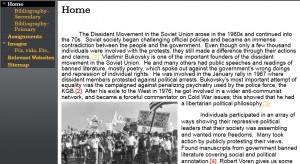Last week on this blog, I discussed how I started teaching students digital skills through class-sourced website assignments. There, I gave a brief introduction to class-sourcing, which involves faculty assigning students to create online projects instead of traditional papers and other assignments, and links to my website that describes the theory and practice of class-sourcing. This week, I want to discuss briefly how I adapted class-sourced website assignments over the three classes that I have taught them, as well as the broader implications of class-sourced assignments.
There are two key ways I have adapted class-sourced website assignments for my future students. First, I have thought through more consciously about the needs of those who would be using the websites in the future, and primarily students and educators at the college and high school level. I have therefore sought to adapt the assignments to fit these needs, and thus asked students creating the website to add a new section to the websites, where they would provide some examples of class activities that educators can assign to those they teach or that learners can do on their own as a way of gaining more from the website. This activity is available to any teacher who assigns a class-sourced assignment. Here is an example of one website that I have assigned in several classes and which has worked well, and here is another I intend to assign to future classes (Figure 1). Second, I have taken websites created by my students in former classes and assigned them to those in my subsequent classes. Learners thus received an opportunity to engage with class-sourced assignments as consumers before they would be the creators of similar class-sourced online projects. This activity is available to those educators who want to assign class-sourced materials made by others as supplementary materials, depending on the availability of topical class-sourced materials. Let me briefly add that I have branched out of doing only class-sourced website assignments and have done online bibliographies through www.Delicious.com, and visual analysis projects through www.Pinterest.com, all available on my website, www.glebtsipursky.com.
The second big question I wanted to discuss in this blog post is a vision for the future. Drawing on my experience, I contend that class-sourced assignments produce content well suited to teaching others. In fact, these and similar classsourced artifacts have the potential to satisfy the demand among faculty and high school teachers for free class materials, especially ones available on the internet where learners spend so much of their time. Since faculty guide their creation, these products can be specifically tailored to the needs of teaching and learning, in comparison to crowdsourced sources such as Wikipedia. Moreover, since faculty check and correct their students’ assignments, class-sourced artifacts deserve more trust than crowdsourced data that lacks such evaluation. Furthermore, there can be many digital artifacts dealing with the same topic: by presenting a diversity of perspectives and interpretations, classsourced materials can offer a fuller and richer portrayal than the cohesive and unified narrative style of either Wikipedia or textbooks.
Once enough have been created and compiled together in an organized fashion, classsourced projects would serve as a valuable informational resource for the public. Such efforts to organize these artifacts can start at the level of individual faculty, as I did with my personal webpage, and grow to span departments, universities, and eventually the national and even international level. Faculty can partner with schools, museums, governments, businesses, non-profit organizations, and other institutions to create digital artifacts that serve the particular needs of such external stakeholders. In this age of digital technology and tightening budgets, class-sourcing would help ensure that history stays relevant and demonstrates actively the value of academic contributions to society as a whole.






